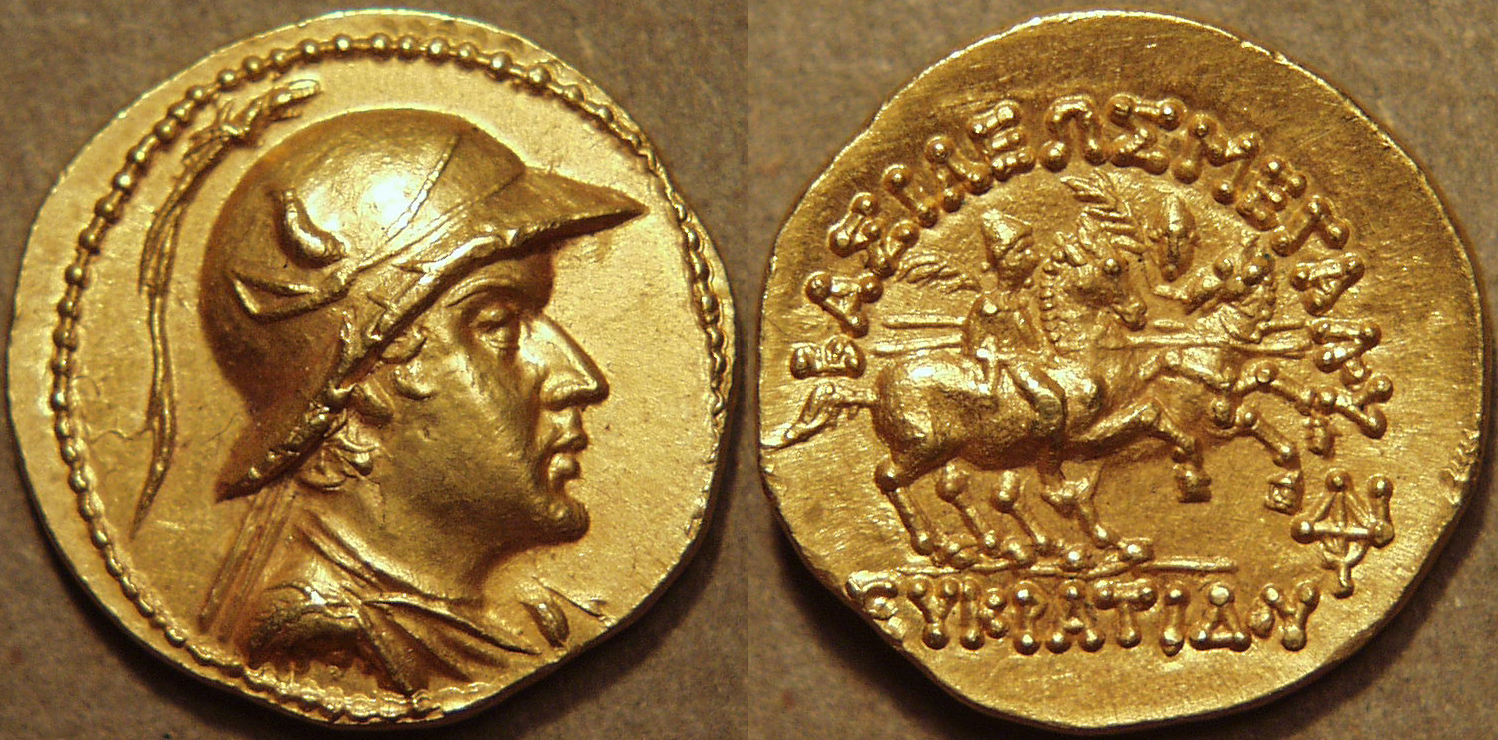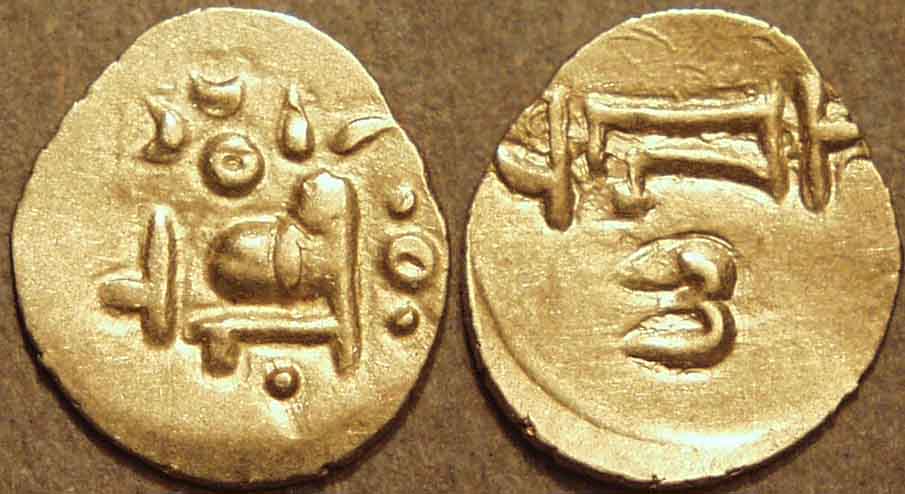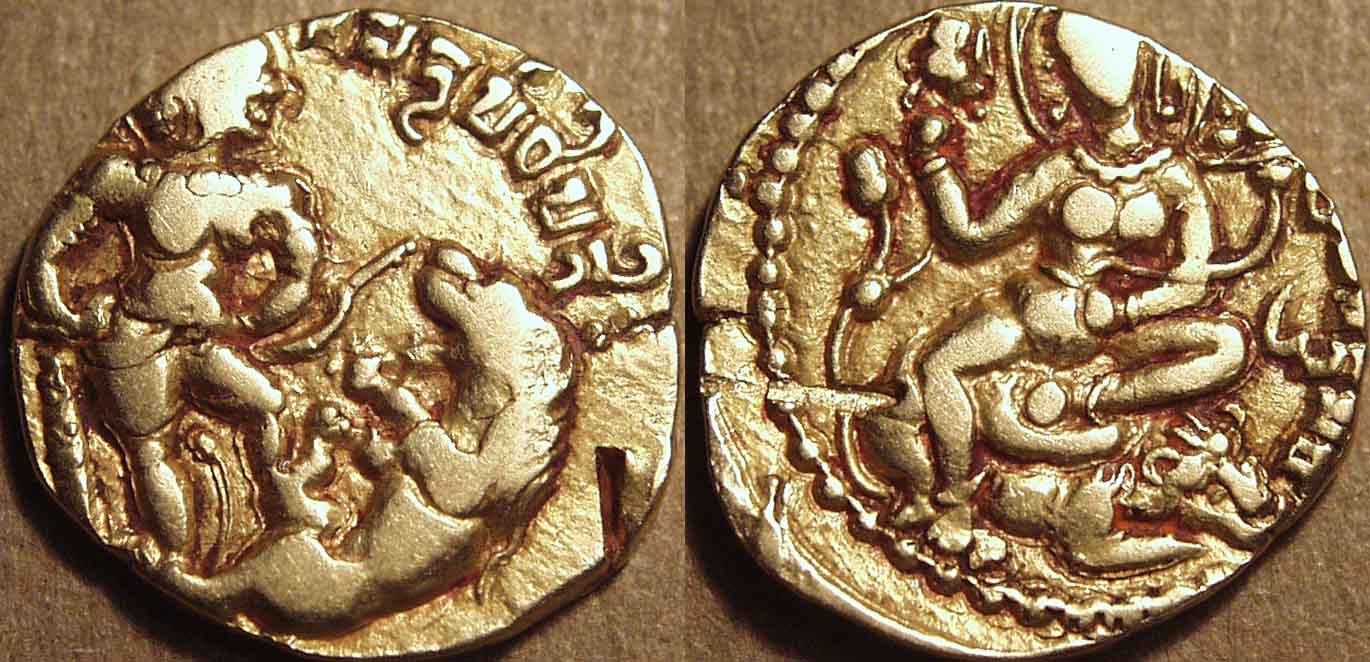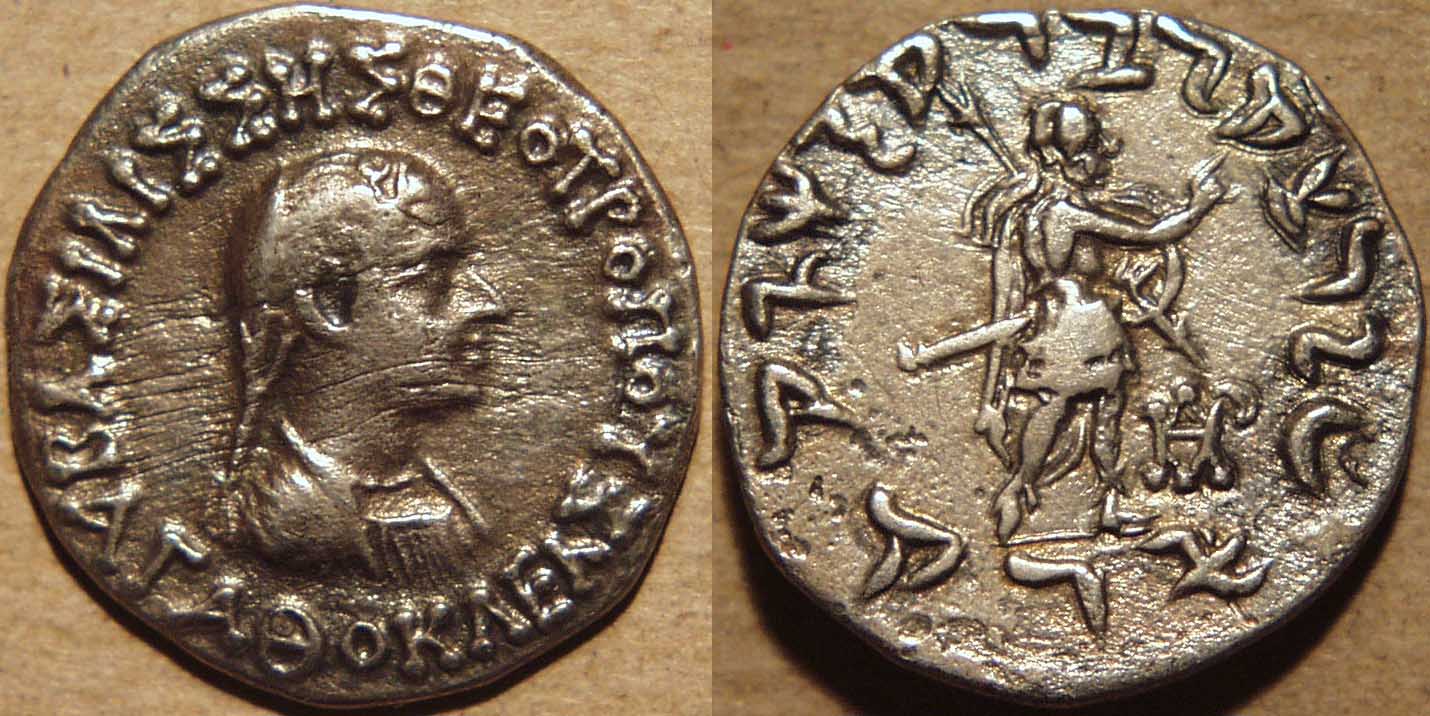
|
|
|

|
Kalachuris of Mahismati: Buddharaja ? silver fraction
Elephant walking left, ridden by mahout and king ? /
Bull Nandi seated left, Brahmi legend above: buddharajadeva ?
Weight: 0.81 gm, Diameter: 8 mm., Die axis: 10 o'clock
Ref: previously unpublished
|
 |
The attribution of this coin, previously unpublished, is highly tentative. The bull on the reverse points clearly to a Kalachuri
origin, as its form matches exactly the Nandi from Cave 22 of Ellora, and other Kalachuri coins. The elephant on the obverse
does not seem to have any clear precedent or fore-runner. Further, although the reading is quite uncertain, it is possible to see the legend as
reading buddharajadeva. Admittedly, in his inscriptions, Buddharaja is always referred to as just Buddharaja, without the title deva at the end, so I'm not so sure this
coin is his. More information is needed before we can gain any confidence in attributing this coin. Note the possible sri below the bull, which would make the legend sri
buddhrajadeva.
You can see more coins of the Kalachuris on the Kalachuris of Mahismati page.
|

|
Bactria: Eucratides I, Gold stater, c. 171-145 BCE
Weight: 8.47 gm., Diam: 20 mm., Die axis: 12 h
Helmeted and diademed bust of king facing right, dotted border around,
the helmet plumed and decorated with the ear and horn of a bull /
Dioscuri riding horses prancing right, carrying spears and palms
Greek legend: BAΣIΛEΩΣ MEΓAΛOY EYKPATIΔOY (of Great King Eucratides)
|
|
Eucratides I ("the Great" ... name also spelled Eukratides) is one of the few Greek kings in India about whom we know something from literary sources. The second century
Roman historian Justin described him as a great man, who commenced his rule around the same time as Mithridates in Parthia (171 BCE). Eucratides was almost certainly a scion of
the Seleucid royal house, who attempted to "re-claim" the throne of the Bactrian kingdom. His "Pedigree" coins (seen on the
Eucratides I page) show his parents,
Heliocles and Laodice, but only his mother Laodice wears a diadem, indicating that she was of royal blood. .
The helmeted type of Eucratides is considered one of the great masterpieces of Bactrian portraiture. The gold stater is very rare, but the type is more easily available in the silver
tetradrachm denomination. The type was also minted in a magnificent 20-stater gold piece, seen on the Eucratides I page
, where you can see more coins of Eucratides.
|

|
Eastern Gangas: Bhanudeva III (1352-78) or Narasimha IV (1378-1414)
Gold fanam
Weight: 0.47 gm., Diam: 10-11 mm., Die axis: 12 o'clock
Stylized humped bull seated right, symbols at right and above /
Stylized Kannada sa flanked by elephant goad and battle axe ?
(Regnal) date below: 2
|
|
The Eastern Gangas were a dynasty who ruled Kalinga (mostly modern Orissa) from the 9th to the 15th centuries. They were the builders of the famous Konarak Sun Temple, a
World Heritage Site, and the Jagannath Temple in Puri. Their only known coins are a series of gold fanams of just under 0.50 gm and some rare quarter fanams. So far, no one has been
able to attribute these coins to individual kings. In a recent paper (to appear in the journal Numismatic Digest), I
have attempted for the first time to make some tentative attributions.
You can see more coins of the Eastern Gangas on the Eastern Gangas page). |

|
Guptas: Kumaragupta I (c. 415-455)
Gold dinar
Weight: 8.16 gm, Diameter: 19 mm.
King standing right, trampling lion at right,
circular Brāhmī legend above: (simha)nripadhipati /
Lakshmi (Durga?) seated facing on couchant lion right, holding a lotus blossom in each hand
Brāhmī legend at right: Sri Mahendrasimha
|
|
A remarkable and apparently unique coin that has been dubbed the "Lion-Conqueror" type or "Lion-killed" type. While Kumaragupta's lion-slayer types normally show the king with a drawn
bow attacking a living lion, here the king is standing triumphantly over the carcass of an animal he has presumably just killed. A coin with the king in a similar pose, but with a different legend,
is in the Lucknow Museum. I have recently written a short article discussing these two coins which has been published in the Journal of the Oriental Numismatic Society. You can
see the original draft of the article, here.
You can see more coins of Kumaragupta on the Kumaragupta page |

|
Indo-Greeks, Agathocleia, Queen Regent to Strato I, c. 135-125 BCE
Silver drachm
Weight: 2.20 gm. Diameter: 17 mm Die axis: 12h
Diademed bust of queen right, Greek legend around:
BAΣIΛIΣΣHΣ ΘEOTPOΠOY / AΓAΘOKΛEIAΣ
(Basilisses Theotropou Agathokleias ... of god-like Queen Agathocleia)
Diademed king walking right, holding bow, arrow and spear,
monogram at right,
Kharoshthi legend around: maharajasa tratarasa dhramikasa / stratasa
of King Strato, the savior, the just
Reference: MIG 303a, Bop 2A
|
|
As far as I can tell, this is the only Indian coin to feature a solo portrait of a living female ruler prior to the 18th century. Some women appear on coins together with their
husbands, but this is the only one in which a queen appears by herself on the coin. Agathocleia may have been the wife of the most famous Indo-Greek king, Menander I,
and may herself have been of royal descent. It appears that she served as queen regent for her son, Strato I, who was a minor at the time of his accession to the throne.
They ruled in Gandhara and Punjab. On this coin, Agathocleia refers to herself as "god-like" and later her son Strato called himself "the manifest," implying that he was
a god.
You can see more coins of Agathocleia on the Agathocleia page and the coins of Strato I on the
Strato I page. |

|
Alchon Huns: Bharana silver drachm, c. early-6th century
Crowned bust of king right, wearing diadem with crescent forehead ornament
and hanging ribbon ends, lunar crescents on shoulders, solar disc at right,
conch at left, Brahmi legend above: jayatu bharana, dotted border around /
Large fire altar flanked by attendants, dotted border around
Weight: 3.59 gm, Diameter: 27.5 mm., Die axis: 10 o'clock
Ref: Göbl --- (unpublished)
|
|
Bharana, known only from his coins, was a king in the dynastic line of the well-known Hun king Toramana. |
 |
Mughal: Shah Jahan III, 1759-60, Silver rupee, Shahjahanabad
Weight: 11.33 gm. Diameter: 22 mm Die axis: 3 o'clock
Legend, naming Shah Jahan, including AH date (117)3 ( = 1759-60 CE)
in the second line of the obverse
Legend, including mint name Dar us Sultanat Shahjahanabad (Delhi), and regnal year 1 (ahd)
Ref: KM 475.3
|
|
Shah Jahan III was the great grandson of Aurangzeb, who ruled for less than a year during 1759-60.
This coin has a fascinating history. Shailendra Bhandare (Journal of the Oriental Numismatic Society 209) discovered that it was almost certainly struck on
6 August 1760 on the orders of the invading Maratha general Sadashiv Rao, known as Bhau. Bhau had been ordered by the Peshwa to journey north to provide aid to
the beleagured Mughal state in defense against the invading Afghan armies, but he arrived in Delhi short of funds and in arrears to his troops. Accordingly, he ordered
the silver lining on the roof of the Diwan-i-khas,
the "Hall of Private Audience" in Delhi's Red Fort to be stripped off and converted to coin. Apparently 900,000 coins were struck from that silver and this coin is one of those.
Bhandare was able to figure this out by looking at the placement of the AH date on the coin. Note that it is placed here on the second line of the obverse (only the 3 is
visible on the coin), a practice followed by the Marathas while they occupied Delhi. Shah Jahan III's original rupees placed the AH date on the third line of the obverse. So the
silver in this coin at one time adorned the roof of a major hall at the Red Fort!
More late Mughal coins can be seen on the Later Mughals page. |
 |
Mewar: Rana Raimalla (1473-1509) AE half falus
Weight: 3.67 gm. Dimensions: 11 x 13 mm Die axis: 12 o'clock
Nagari legend: sri ra(na ra) / yamalla /
Legend imitating coins of Malwa sultans
Reference: unpublished
|
|
This is the first known coin of Rana Raimalla of Mewar (ruled 1473-1509). It can be quite conclusively identified by the presence of the unusual last letter
in the second line, a retroflex la still used in the Marathi script and here standing for the double la in the king's name. Raimalla was the younger son of Rana
Kumbha, who succeeded to the throne after deposing his older brother Uda. Uda had murdered his father in order to attain the throne and faced considerable opposition
from the nobles of the realm.
More coins of Mewar can be seen on the Mewar page. |
 |
FORGERY of a silver drachm of the Indo-Greek king Philoxenus
Weight: 1.93 gm. Dimensions: 14 x 14 mm Die axis: 12h
Diademed and helmeted bust of king right, Greek legend around:
BAΣIΛEΩΣ / ANIKHTOY / ΦIΛOΞENOY
Helmeted king mounted on prancing horse right,
monograms below at right and left,
Kharoshthi legend around: maharajasa / apadihatasa / philasinasa
Reference: see MIG 341e, Bop 6D
| |
This coin is a forgery of an Indo-Greek silver drachm that I acquired (as supposedly genuine) in 2013 from a source in Pakistan. As prices of Indian coins have risen
considerably in recent years, the problem of forgeries is becoming more acute. I feature this coin in the hope that it can help collectors identify (and stay away from!) similar
forgeries.
The coin purports to be a silver drachm of the Indo-Greek king Philoxenus. You can see a genuine coin of this type here.
On the face of it, and based on the photos I saw when evaluating the coin, the coin looks excellent. The style is absolutely correct and the condition looked good. Once I got the
coin in hand, though, the slight roughness of the surface and the uniform blackish patina got me worried. The patina especially looked artificial, as if some chemical had been
rubbed on an otherwise silvery surface to give it the appearance of age. Look at the enlargement of the photo and you will see what I mean. Given my doubts, I looked at the
edges of the coin, and this confirmed my suspicions. The edges showed parallel grooves all over ... the tell-tale marks of a modern file having been used to "smooth" the edges.
A couple of the edges also showed "ridges" ... the center of the edge was slightly higher than the rest ... proof that the coin had been cast. When a coin is cast, molten metal
is poured between two moulds that are held tightly together. A small "rim" is left in between the two moulds along the edge and this needs to be filed away to hide the fact that
the coin has been cast. The makers of this fake didn't get rid of this "rim" entirely. You can see the detailed images of the edges of the fake coin
here and the edges of the genuine coin
here. The photos make the differences quite clear.
This type of forgery (a cast copy made from an original coin) is different from other types of forgeries where the forger takes a genuine coin and then carves on it to
create something "enhanced" or entirely new. I wrote a paper on that kind of forgery which was published in the Journal of the Oriental Numismatic Society, No. 204 (Summer 2010)
and those who are interested can read my draft here. Curiously, on the day I was writing this, I discovered that coin (b) in
Figure 6 of my paper, supposedly a bronze coin of the Kushan king Kanishka with a standing Buddha reverse, was being offered for sale in a German auction and it apparently
sold for 100 euros on a single bid. This was a sure sign that all but one potential bidder understood the coin to be a fake; if genuine, the coin would be worth around $750 or so.
More genuine coins of Philoxenus can be seen on the Philoxenus page. |
 |
Bactria: Eucratides I, Silver hemi-obol, c. 171-145 BCE
Weight: 0.27 gm., Diam: 9 mm., Die axis: 12 h
Helmeted and diademed bust of king facing right, dotted border around,
Caps and palms of the Dioscuri, Π Γ monogram below
Greek legend: BAΣIΛEΩΣ EYKPATIΔOY (of King Eucratides)
Reference: unpublished
|
|
This rather unassuming coin is a new discovery I made at the January 2014 New York International Numismatic Convention. The low weight and small size of this coin,
including the small sizes of all the devices on it, mark this as a true hemi-obol rather than an obol. The denomination is unlisted in all the usual catalogs, where the obol
is so far the smallest known denomination of Eucratides. In a world where an increasing commercialization of the market is forcing more and more coins to be
"imprisoned" in slabs and where collectors vie with each other for the most mint-state example of the commonest coins, I personally find a much greater reward in
discovering "gems" such as this coin.
Eucratides I ("the Great" ... name also spelled Eukratides) is one of the few Greek kings in India about whom we know something from literary sources. The second century
Roman historian Justin described him as a great man, who commenced his rule around the same time as Mithridates in Parthia (171 BCE). Eucratides was almost certainly a scion of
the Seleucid royal house, who attempted to "re-claim" the throne of the Bactrian kingdom. His "Pedigree" coins show his parents,
Heliocles and Laodice, but only his mother Laodice wears a diadem, indicating that she was of royal blood. Eucratides
must have defeated several Greek kings in India, including possibly Agathocles, Antimachus I, Demetrius II, Apollodtus I and Antimachus II. It is likely that the Greek kingdom in
Bactria and India had fractured and Eucratides may have re-united it, thereby earning him the moniker "the Great." Justin names only one king who opposed Eucratides, Demetrius
of India. This was possibly Demetrius II, although opinion is divided on this issue. Eucratides was the last Greek king to rule at Ai-Khanoum, which was overrun most probably by the
Yuezhi, the tribes that later coalesced into the Kushans. Eventually, Justin tells us, Eucratides was killed by his own son, who made no attempt to hide
his deed and in fact ran his chariot through his father's blood and ordered his body to be cast out unburied. Unfortunately, Justin does not name this son, so we don't know if it was
any of the subsequent Greek kings who issued coins.
More coins of Eucratides, including the "Pedigree" coins mentioned above, can be seen on the Eucratides page.
|
|
|